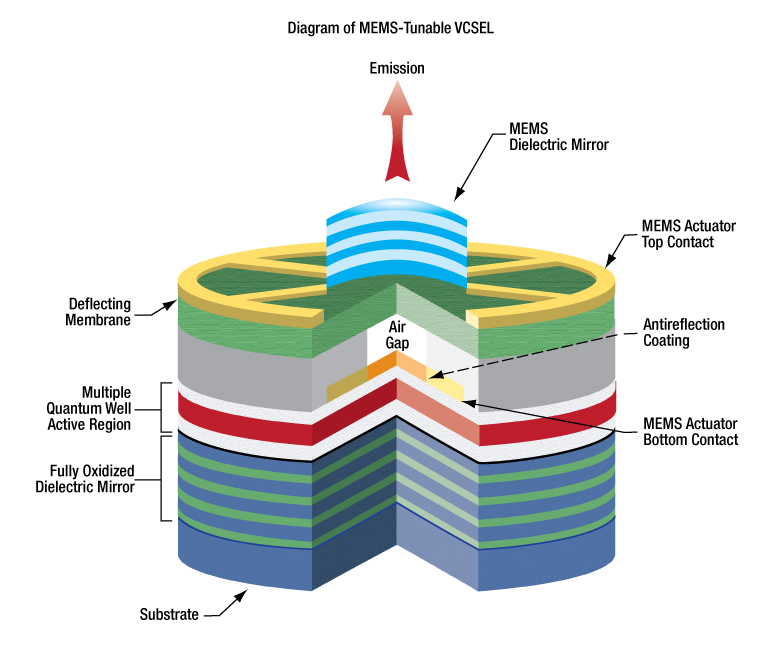The VCSEL market (Vertical Cavity Surface Emitting Laser) is experiencing significant growth as demand for high-performance optical components surges across multiple industries. From facial recognition in smartphones to high-speed data transmission in data centers, VCSELs have emerged as an essential laser technology due to their compact size, low power consumption, and precise beam characteristics.

A VCSEL is a semiconductor laser diode that emits light perpendicular to the surface of the wafer, rather than parallel as in edge-emitting lasers. This unique architecture allows for superior performance in applications requiring speed, accuracy, and scalability.
Key Drivers of the VCSEL Market
Several factors are accelerating the growth of the VCSEL market:
Increased Adoption in Consumer Electronics: VCSELs are widely used in 3D sensing applications, particularly in smartphones for features like facial recognition, proximity sensing, and gesture control.
Rising Demand in Data Communication: Data centers and high-speed networking rely on VCSELs for optical interconnects due to their reliability and energy efficiency.
Advancements in Automotive Applications: VCSELs support LiDAR systems and in-cabin monitoring, crucial for the advancement of autonomous vehicles and ADAS (Advanced Driver Assistance Systems).
Growth in Industrial and Medical Fields: VCSEL technology is being used in laser printing, optical encoders, and diagnostic medical equipment.
Emerging Trends in the VCSEL Market
As the VCSEL market matures, several trends are shaping its future:
Miniaturization and Integration
Manufacturers are developing smaller VCSEL arrays that can be embedded into compact devices without compromising performance, particularly for wearables and augmented reality systems.Multi-Wavelength and Multi-Channel Designs
To improve efficiency and functionality, VCSELs are being designed to emit multiple wavelengths or operate on multiple channels, especially in optical communication and sensing.Expansion in 3D Sensing
The proliferation of 3D sensing across smartphones, automotive systems, and smart home devices is fueling a wave of innovation and demand in the VCSEL space.Technological Convergence
Integration with AI, machine vision, and edge computing is creating new use cases and expanding the scope of VCSEL applications in both consumer and enterprise environments.
Market Segmentation Overview
The VCSEL market is segmented by type, material, application, and region.
By Type: Single-mode and multi-mode VCSELs
By Material: Gallium Arsenide (GaAs), Indium Phosphide (InP), and others
By Application: Consumer electronics, data communication, automotive, industrial, healthcare, and defense
Regional Analysis
North America remains a leading region due to technological leadership and high investments in R&D, particularly in the U.S.
Asia-Pacific is rapidly expanding, driven by large-scale manufacturing in China, Japan, and South Korea along with strong demand from consumer electronics.
Europe contributes significantly, especially in automotive and industrial automation sectors.
Major Players in the VCSEL Market
The competitive landscape of the VCSEL market includes both established companies and emerging startups. Key players include:
Lumentum Holdings Inc.
II-VI Incorporated
Broadcom Inc.
TRUMPF GmbH + Co. KG
AMS OSRAM
Vixar Inc.
Leonardo Electronics
Panasonic Industry Co., Ltd.
These companies are heavily investing in expanding production capabilities, developing next-gen VCSELs, and entering into strategic partnerships.
Challenges Facing the VCSEL Market
Despite its promising trajectory, the VCSEL market faces several challenges:
Thermal Management Issues: High-performance VCSELs can generate excess heat, requiring sophisticated cooling systems to maintain efficiency.
Cost Pressures: While demand is increasing, pricing pressures in consumer markets can affect profitability for suppliers.
Standardization and Testing: Ensuring compatibility and reliability across diverse platforms requires rigorous standards and testing protocols.
Future Outlook
The future of the VCSEL market looks highly promising, with projected compound annual growth rates in the double digits. The ongoing transition to 5G, growth in AI-powered systems, and advancements in electric and autonomous vehicles will continue to drive demand. Emerging sectors such as smart glasses, robotics, and quantum computing also present untapped potential for VCSEL deployment.
As miniaturization, efficiency, and mass production improve, VCSELs will become even more critical to the development of next-generation optical solutions. Industry stakeholders must stay ahead of innovation trends and invest strategically to capitalize on this expanding market.







